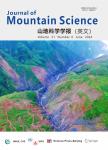Deformation characteristics and damage ontologies of soft and hard composite rock masses under impact loading
作者机构:Architectural and Civil Engineering CollegeXi’an University of Science and TechnologyXi’an 710054China
出 版 物:《Journal of Mountain Science》 (山地科学学报(英文))
年 卷 期:2024年第21卷第5期
页 面:1715-1727页
核心收录:
学科分类:0830[工学-环境科学与工程(可授工学、理学、农学学位)] 08[工学] 080104[工学-工程力学] 0801[工学-力学(可授工学、理学学位)]
基 金:supported by the Xi’an Key Laboratory of Geotechnical and Underground Engineering Open Fund Project (XKLGUEKF20-03) the Natural Science Basic Research Program of Shaanxi Province General Project-Youth Project(2024JC-YBQN-0258)。
主 题:Soft and hard composite rock mass Dynamic properties Split Hopkinson pressure bar(SHPB) Numerical simulation Intrinsic damage model
摘 要:As one of the most common occurring geological landforms in deep rock formations, the dynamic mechanical properties of layered composite rock bodies under impact loading have been widely studied by scholars. To study the dynamic properties of soft and hard composite rocks with different thickness ratios, this paper utilizes cement, quartz sand and gypsum powder to construct soft and hard composite rock specimens and utilizes a combination of indoor tests, numerical calculations, and theoretical analyses to investigate the mechanical properties of soft and hard composite rock bodies. The test results reveal that:(1) When the proportion of hard rock increases from 20% to 50%, the strength of the combined rock body increases by 69.14 MPa and 87 MPa when the hard rock face and soft rock face are loaded, respectively;however, when the proportion of hard rock is the same, the compressive strength of the hard rock face impact is 9%-17% greater than that of the soft rock face impact;(2) When a specimen of soft and hard combined rock body is subjected to impact loading, the damage mode involves mixed tension and shear damage, and the cracks generally first appear at the ends of the specimen, then develop on the laminar surface from the impact surface, and finally end in the overall damage of the soft rock part. The development rate and the total number of cracks in the same specimen when the hard rock face is impacted are significantly greater than those when the soft rock face is impacted;(3) By introducing Weibull’s statistical strength theory to establish the damage variables of soft-hard combined rock bodies, combined with the DP strength criterion, the damage model and the Kelvin body are concatenated to obtain a statistical damage constitutive model, which can better fit the full stress-strain curve of soft-hard combined rock body specimens under a single impact load.



